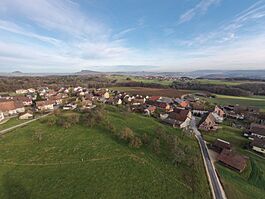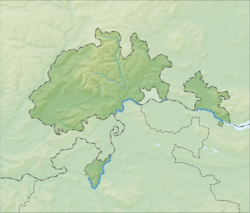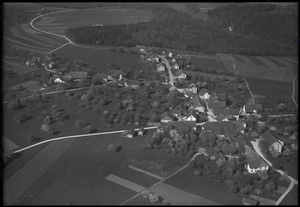Büttenhardt facts for kids
Quick facts for kids
Büttenhardt
|
||
|---|---|---|
 |
||
|
||
| Country | Switzerland | |
| Canton | Schaffhausen | |
| District | n.a. | |
| Area | ||
| • Total | 4.0 km2 (1.5 sq mi) | |
| Elevation | 658 m (2,159 ft) | |
| Population
(Dec 2020 )
|
||
| • Total | 437 | |
| • Density | 109.3/km2 (283/sq mi) | |
| Postal code |
8236
|
|
| Surrounded by | Lohn, Merishausen, Opfertshofen, Schaffhausen, Stetten, Tengen (DE-BW) | |
Büttenhardt is a small town, also called a municipality, in Switzerland. It is located in the canton of Schaffhausen. A canton is like a state or a region in Switzerland.
Contents
History of Büttenhardt
Büttenhardt was first mentioned in old records in the year 1238. It was called Butinhart back then. The village became part of Switzerland in the 1300s.
A special part of Büttenhardt's history involves a place called Verenahof. This area used to belong to West Germany. It was a German exclave inside Switzerland. An exclave is a piece of land that belongs to one country but is completely surrounded by another country. Verenahof was separated from the rest of West Germany by a small strip of Swiss land.
In 1964, Switzerland and West Germany made a deal. They signed a treaty that changed the borders. This treaty became official in 1967. The 43-hectare area of Verenahof, with its few houses and people, became part of Switzerland. In exchange, Switzerland gave West Germany an equal amount of land from different Swiss towns.
After this land swap, Verenahof became part of the Swiss municipality of Büttenhardt. Another German exclave, Büsingen am Hochrhein, still remains part of Germany, surrounded by Switzerland.
You can still see some old border markers from the 1930s in Büttenhardt. They are used to frame bushes around what used to be the German exclave.
Geography of Büttenhardt
Büttenhardt covers an area of about 4 square kilometers (1.5 square miles). A large part of this land, almost half (48.8%), is used for farming. Another big part (45.3%) is covered by forests. The remaining small portion (6%) has buildings and roads.
The municipality is located in an area called the Reiat district. It is a farming village. It sits north of the city of Schaffhausen on a rocky ridge called the Reiatrücken.
People of Büttenhardt
Büttenhardt has a population of about 423 people. In 2008, about 8.6% of the people living there were from other countries. Most of these foreign residents were from Germany.
Over the last ten years, the number of people living in Büttenhardt has slightly decreased. Most people (95.9%) in Büttenhardt speak German. English is the second most common language, and Italian is the third.
In 2008, about 24.1% of the population were children and teenagers (0–19 years old). Adults (20–64 years old) made up 63.6% of the population. People over 64 years old made up 12.3%.
In the 2007 national election, the most popular political party was the SVP. They received 46.9% of the votes. The next two most popular parties were the SP (30.3%) and the FDP (22.8%).
Most people in Switzerland have a good education. In Büttenhardt, about 87.7% of adults (aged 25–64) have finished high school or gone on to higher education. This includes university or a specialized college.
In 2007, a small number of children (0.29%) attended kindergarten or preschool. About 6.94% attended Primary School. About 4.91% attended a lower level Secondary School. And 4.05% attended a higher level Secondary School.
In 2000, about 15.8% of the people belonged to the Roman Catholic Church. About 67.8% belonged to the Swiss Reformed Church.
Here is how the population of Büttenhardt has changed over time:
| year | population |
|---|---|
| 1836 | 148 |
| 1850 | 195 |
| 1880 | 220 |
| 1900 | 166 |
| 1910 | 142 |
| 1950 | 192 |
| 1970 | 161 |
| 1990 | 269 |
| 2000 | 342 |
| 2020 | 423 |
Jobs in Büttenhardt
Büttenhardt has a very low unemployment rate, which means almost everyone who wants a job has one. In 2005, 28 people worked in the primary economic sector. This sector includes jobs like farming and forestry. There were 11 businesses in this area.
Fifteen people worked in the secondary sector. This includes jobs like manufacturing and construction. There were 4 businesses in this sector. Seventeen people worked in the tertiary sector. This includes jobs in services, like shops and offices. There were 6 businesses in this sector.
In 2008, the average unemployment rate was 0.5%. About 72.3% of the working people had full-time jobs. About 27.7% worked part-time. There were 47 people living in Büttenhardt who worked. About 42.6% of these workers were women.
In 2000, 35 people worked in Büttenhardt itself. However, 142 people who lived in Büttenhardt worked outside the municipality. Also, 19 people traveled into Büttenhardt for work.
As of 2008, Büttenhardt has 1 restaurant and 1 hotel with 43 beds. The hotel and restaurant business employs 1 person.
Education in Büttenhardt
The Schule Büttenhardt-Lohn serves the children of Büttenhardt. This school system includes a preschool campus in Lohn. It also has primary school campuses in Büttenhardt (for grades 1–3) and Lohn (for grades 4–6).
Children from Büttenhardt started attending the Lohn preschool in the 2009–2010 school year. The primary schools in Büttenhardt and Lohn combined in the 2008–2009 school year. For older students, the closest secondary school is Schulhaus Gräfler in Schaffhausen.
See also
 In Spanish: Büttenhardt para niños
In Spanish: Büttenhardt para niños






